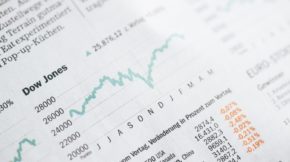TSX: 2015 Black Mondays
Share

2015 has been a weak year for the Toronto Stock Exchange (TSX), and Global Equities. Major stock indexes around the world entered the Market Correction territory as stocks declined more than 10% from its 2015 peak. This provides a great buying opportunity for long term investors, once the market shows signs of bottoming out.
Year-to-date, the TSX is down a little more than 5.5%, slightly underperforming the S&P 500, which is down approximately 2.5% (as of October 15). In Finance, there is a term known as “Black Monday.” Black Monday specifically refers to Monday, October 19th, 1987 – when stock markets around the world crashed, and declined in value in a relatively short period of time. It was like a snowball effect – the crash began in Hong Kong, continued spreading west to Europe, and finally hit the North American markets.
Global Markets
A similar pattern can be noticed in 2015, in regards to the Chinese stock market, which had a huge correction after investor worries over economy growth, and restrictions on margin investing. The Chinese stocks had an impact on global stocks – as investors would flee to cash, due to concerns over the Chinese stock markets.
During the time of the Chinese stock market downfall, Greece’s economy reached a new low, as the government defaulted on debt payments. The combination of these two events during mid 2015 caused a lot of uncertainty for investors.
Canadian Economy
According to a Statistics Canada report, the Canadian economy experienced negative growth throughout the first half of 2015. Real GDP contracted 0.5% in the second quarter and 0.8% in the first quarter. The Canadian economy underperformed the US economy, which grew 3.7% in the second quarter.
This is majorly on the result of declining oil prices, which is one of Canada’s largest exports. Lower oil prices were one of the factors contributing to the decline of the Canadian Dollar – to a 10-year low. With the objective of boosting the Canadian economy, the Bank of Canada cut the interest rates twice in 2015, all the way down to 0.5%. Low interest rates contributed to the rise of home prices, as borrowing costs are at an all time low.
In theory, when interest rates decrease, prices of investments increase, whereas the value of the dollar decrease. The interest rate cuts further weakened the Canadian Dollar, thus increasing the prices of imports. During the second quarter, imports of goods and services fell 0.4% (Statistics Canada), suggesting that the weaker Canadian dollar reduces the affordability of foreign goods
Fed Rates
There was speculation that Yellen would increase the Fed rates in the US, one of the biggest economies in the world. Increasing the federal rate negatively impacts the stock markets, and increases the costs of borrowing. Increasing the Fed rate would not have only affected the stock markets, it would have also impacted the value of Canadian dollar – as the US dollar would be more valuable against the Canadian dollar.
Black Mondays
So far in 2015, there has been 7 Mondays where the TSX has dropped more than 1%, although this is not as extreme as the Black Monday of October 19th, 1987 where the Dow lost more than 22% of its value (The Bubble Bubble).
TSX Black Mondays

Source: TMX Money
August 24th was known as the ‘Black Monday’ to some investors – as the Shanghai Composite Index dropped 8.5% in one day, making it the biggest sell of since 2007 (The Guardian).
August 24th Black Monday
- Similar to the Black Monday of 1987, the selloff began in Asia
- US stock markets experienced its biggest sell of in four years – Dow Jones closed down 588 points, after loosing more than 1000 points during the morning.
- London: FTSE 100 index shredded almost £73.9bn
- North American equities entered the correction territory – losing 10% from its 2015 peak
Source: (The Guardian)
Shanghai Stock Exchange (SSE) Composite Index

Despite the downturn beginning in June, SSE is outperforming the North American equities, as its year to date is +3.2% (as of October 15th).
What caused the Black Monday?
The major cause of the Black Monday in 1987 was the Securities Exchange Commission (SEC)’s difficulty to reduce “shady” IPOs, and a rise of investigations for illegal insider trading (The Bubble Bubble). This lead to many investors to worry – and put in sell orders immediately. The overflow of sell orders leads to the Dow to loose over $500 billion in a single day.
In fact, some Brokers lost their lives during Black Monday, as some investors decided to go to their Brokers office and shoot the employees (The Bubble Bubble).
Conclusion
Clearly, non of the Mondays in 2015 compares to the Black Monday that happened in 1987. The worst Monday of the year occurred on August 24th, where the TSX lost 3.12%. The weak performance of the TSX is due to many economic factors, such as the weakening Canadian dollar, Greece’s economy, and investor worries over the Chinese stock market.
Historically, the stock market is impacted by different market trends that impact investor’s concerns. In other words, when there is a major economic concern, such as the slow down of the Chinese economy, some investors would place sell orders in order to flee to cash. These sell orders cause the market to go down in value. However, it potentially provides a great buying opportunity for long term investors.
Writer: Jelani Smith
Disclaimer: All investing can potentially be risky. Investing or borrowing can lead into financial losses. All content on Bay Street Blog are solely for educational purposes. All other information are obtained from credible and authoritative references. Bay Street Blog is not responsible for any financial losses from the information provided. When investing or borrowing, always consult with an industry professional.






Bay Street Blog Newsletter
Click here to subscribe for a financial savvy experience.
Please check your email to confirm subscription!